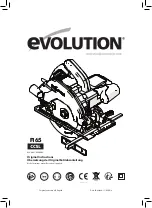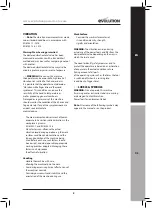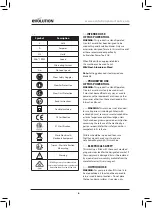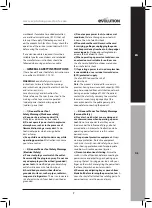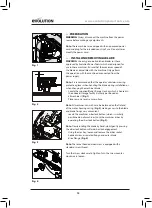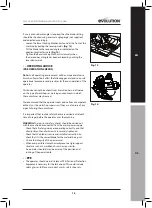
7
www.evolutionpowertools.com
EN
DE
workbench if available. For added protection
use a residual current device (R.C.D.) that will
interrupt the supply if the leakage current to
earth exceeds 30mA for 30ms. Always check the
operation of the residual current device (R.C.D.)
before using the machine.
If an extension cable is required it must be a
suitable type for use outdoors and so labelled.
The manufacturers instructions should be
followed when using an extension cable.
(2.1)
GENERAL SAFETY INSTRUCTIONS
(These General Power Tool Safety Instructions are
as specified in EN 62841-1: 2015).
WARNING:
Read all safety warnings and
instructions. Failure to follow the warnings
and instructions may result in electric shock, fire
and/ or serious injury.
Save all warnings and instructions for
future reference. The term “power tool” in the
warnings refers to your mains-operated
(corded) power tool or battery-operated
(cordless) power tool.
(2.2)
1) General Power Tool
Safety Warnings [Work area safety]
a) Keep work area clean and well lit.
Cluttered or dark areas invite accidents.
b) Do not operate power tools in explosive
atmospheres, such as in the presence of
flammable liquids, gasses or dust. Power
tools create sparks which may ignite the
dust or fumes.
c) Keep children and bystanders away while
operating power tool. Distractions can cause
you to lose control.
(2.3)
2) General Power Tool Safety Warnings
[Electrical Safety]
a) Power tool plugs must match the outlet.
Never modify the plug in any way. Do not use
any adapter plugs with earthed (grounded)
power tools. Unmodified plugs and matching
outlets will reduce risk of electric shock.
b) Avoid body contact with earthed or
grounded surfaces, such as pipes, radiators,
ranges and refrigerators. There is an increased
risk of electric shock if your body is earthed or
grounded.
c) Do not expose power tools to rain or wet
conditions. Water entering a power tool will
increase the risk of electric shock.
d) Do not abuse the cord. Never use the cord
for carrying, pulling or unplugging the power
tool. Keep cord away from heat, oil, sharp edges
or moving parts. Damaged or entangled cords
increase the risk of electric shock.
e) When operating a power tool outdoors, use
an extension cord suitable for outdoor use.
Use of a cord suitable for outdoor use reduces
the risk of electric shock.
f) If operating a power tool in a damp location
is unavoidable, use a residual current device
(RCD) protected supply.
Use of an RCD reduces the risk of
electric shock.
Note: The product is intended for use only in
premises having a service current capacity≥100A
per phase, supplied from a distribution network
having a nominal voltage of 230V. If required,
contact the electricity company to ensure that
the mains current carrying capacity at the
connection point to the public power grid is
adequate for connecting the product.
(2.4)
3) General Power Tool Safety Warnings
[Personal Safety].
a) Stay alert, watch what you are doing and
use common sense when operating a power
tool. Do not use a power tool while you are
tired or under the influence of drugs, alcohol
or medication. A moment of inattention while
operating power tools may result in serious
personal injury.
b) Use personal protective equipment. Always
wear eye protection. Protective equipment
such as dust masks, non-skid safety shoes, hard
hat or hearing protection used for appropriate
conditions will reduce personal injuries.
c) Prevent unintentional starting. Ensure the
switch is in the off-position before connecting to
power source and or battery pack, picking up or
carrying the tool. Carrying power tools with your
finger on the switch or energising the power tools
that have the switch on invites accidents.
d) Remove any adjusting key or wrench from
blade bolt before turning the power tool on. A
wrench or key left attached to a rotating part of a
power tool may result in personal injury.

